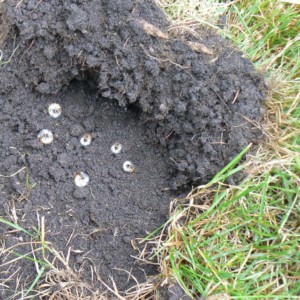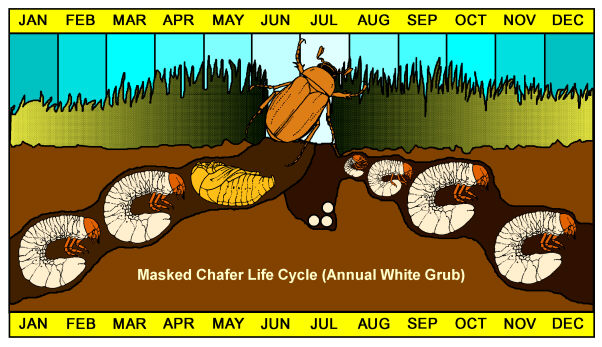
Trying to figure out why you have brown, dying patches in your lawn? It’s possible that you have a white grub infestation. White grubs are insect larvae that feed on the roots of sunny, well-watered lawns during the spring and fall months. They do considerable damage to the root system, causing large, brown areas of dead grass. Untreated lawns will never recover from a severe infestation.
Grubs are the C-shaped larvae of various beetles. Fully-grown larvae are one-half to three-quarters of an inch long. Early indications of grub infestation are irregular patches of dry grass, flocking birds, or entire areas of turf being torn up by raccoons, possums and skunks looking for a tasty treat. Damage can be witnessed by tugging on the grass surface. If grubs have been eating the root system, patches of turf will come up easily from the soil surface, like pulling up a corner of carpeting, and the soil will be full of grubs.

White grubs eventually turn into beetles, e.g., Japanese beetles. If you treat for grubs when they’re smaller, in late summer to early fall, they’re easier to eradicate. White grub life cycles are simple. During summer, adult beetles fly around. Some species (like Japanese beetles) buzz about during the day, while others (like chafers) fly around at night. After these adult beetles mate, they head down into the soil to lay their eggs. Once the eggs hatch, the tiny grubs start to feed on your lawn. This is when they’re so small you often don’t see them or their damage. During September and October, grubs continue to feed and grow. In November, grubs stop feeding and burrow down 3 to 12 inches and make winter cells.
Once spring comes around, the grubs work their way up to your fresh springtime grass to feed on your turf’s tender roots. By this time the grubs have matured, so they can really do significant damage.
What should be done to stop these insects? Typically we recommend a grub-specific insecticide applied as soon as damage is noticed. We recommend following up with a second application at the appropriate time. An organic approach would be to apply beneficial nematodes prior to any infestation. This is not a curative option, but can be used preventively.
